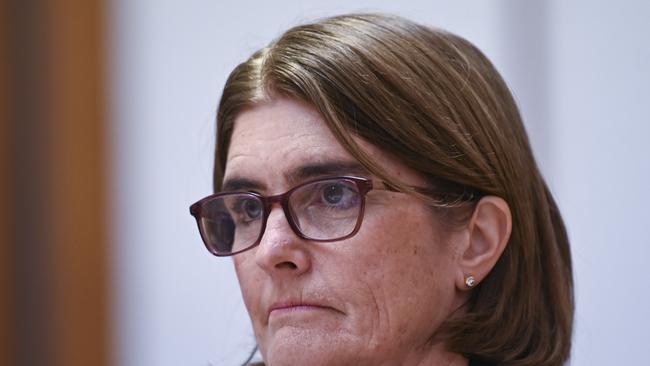RBA financial stability report paints grim picture as cost of living, interest rates bite
An alarming number of Australians are feeling the pinch after 12 interest rate hikes and high inflation, a new RBA report has revealed.

An increasing number of Australians with mortgages are teetering on the edge of financial stress as higher interest payments threaten to exceed incomes and deplete savings, the Reserve Bank has found.
In its biannual health check of Australia’s financial system, released just days after the central bank held the cash rate steady for the fourth consecutive month, the RBA concluded that the Australian financial system remained strong.
But, it found that while most Australians remain well placed to manage the ongoing impacts of high inflation and higher interest rates, 5 per cent of owner-occupier households are exceeding their income when it comes to mortgage repayments and essential expenses.
The RBA said those borrowers were not necessarily in mortgage stress but would likely have to either draw down further on their savings, restructure their loans or consider cheaper education and health insurance options.
In response, Treasurer Jim Chalmers said the report was an “important reminder of the ongoing pressures facing the global financial system and the global economy”.

The review found that most Australian households and businesses remain “well placed” because of the strength of the labour market and the savings buffers.
The bank found that very few had fallen behind on their loan payments so far but a “small but rising share of borrowers are on the cusp, or in the early stages, of financial stress”.
Monthly inflation rose 5.2 per cent in the year to August – well down from the December peak of 7.8 per cent – but still above the RBA’s target range of 2 to 3 per cent.
The bank has hiked the cash rate 12 times since last May in a bid to tame inflation, with the rate now at 4.1 per cent.
Only 70 per cent of the five per cent of owner-occupier borrowers estimated to have a cash flow shortfall have sufficient savings in their offset and redraw accounts to finance any cash flow shortfalls for at least six months if rates remain around current levels.
“The remaining 30 per cent of these borrowers are at risk of depleting their buffers within six months – and so are at higher risk of falling into arrears on their housing loan,” the review said.
While that appears like a lot, the Reserve Bank says only 1.5 per vent of all variable-rate owner-occupiers are at risk of depleting their buffers.
The review said households had been in a better position before the suite of rate rises because the pandemic had allowed them to build up a savings buffer, but the “flow of new savings has slowed, including excess payments into offset accounts and redraw facilities”.
The share of households spending more than 30 per cent on their mortgage payments has risen to 20 per cent, up from 4 per cent last April when rates were last 0.1 per cent.
Dr Chalmers said “we know Australians are doing it tough, and higher interest rates will continue to bite, particularly as more households come off lower fixed-rate mortgages”.
“In these difficult times, the Albanese government is focused on making the budget more responsible and our economy more resilient while rolling out billions of dollars of cost-of-living relief in a way that doesn’t add to inflationary pressures,” he said.

Rising risk of China
The review confirmed what the bank, and Dr Chalmers, had been saying for months – that stress in China’s economy is one of the biggest risks to the global economic outlook.
“Stress in China’s financial system could spill over to the global financial system, including Australia, via slower growth and an increase in risk aversion,” the bank said.
Growth in the Chinese economy has slowed in recent years, exacerbated by the Covid-19 pandemic, and coupled with a sharp deterioration in property market conditions, risks had increased.
The review said China’s financial system stress could affect the broader global system – including Australia – via slower growth and an increase in risk aversion.
“The main effects of financial stress in China on Australia would likely be felt through slowing global economic activity, lower global commodity prices and reduced Chinese imports of Australian goods and services,” the review said.
Dr Chalmers said the slowdown in China was “weighing on global growth and will inevitably contribute to slower growth at home over the year ahead”.

Insolvencies surge
The RBA found businesses remained “resilient overall”, but ongoing cost pressures coupled with softening demand was putting pressure on some businesses’ profitability and liquid reserves.
The bank found that cost pressures and slowing demand were weighing on some businesses more than others, with the strong recovery from the pandemic no longer offering the same level of buffer it once did.
As such, the number of company insolvencies had increased to about pre-pandemic levels, the review found.
While most are small companies, the RBA noted the number of medium and large companies becoming insolvent had “increased of late”.
“Insolvencies of larger businesses are more likely to transmit stress to households and other businesses, as they have more employees, larger debts and more interlinkages with other businesses via trade credit,” the review said.
“Rising insolvencies in the construction industry have accounted for one-third of the increase in insolvencies of late, albeit this upswing has occurred from the very low levels recorded during the pandemic.”
The RBA said there were “limited direct risks” to the banking sector.
“Overall, the risks to the broader financial system stemming from the business sector remain low,” the review said.
The review found that Australian banks remained “well positioned” to continue supplying credit to the economy if economic conditions worsened, and unlike in some other economies, systemic risks from financial institutions outside the banking sector remained low in Australia.




To join the conversation, please log in. Don't have an account? Register
Join the conversation, you are commenting as Logout